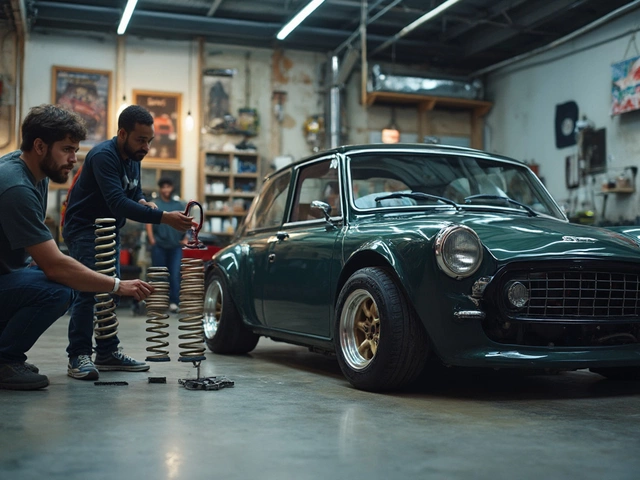Dropped cars look awesome, handle better, and just feel more planted on the road. But here’s a harsh reality—doing it the wrong way can mess up your ride, burn through your wallet, and even land you in danger.
The safest route? Lowering springs. Forget those hacked-up springs or cut coils you see in sketchy DIY videos. Lowering springs are designed to fit your ride, give it the right stance, and actually improve how it handles—without turning every bump into a disaster.
Maybe you’re tempted by coilovers or air suspension kits. They’re impressive but come with a hefty price tag and, unless installed by a pro, can mess up alignment or suspension geometry. Lowering springs keep it simple. Quality brands test them to make sure your shocks don’t blow out and your tires wear evenly.
Before you touch those bolts, remember: safety starts in your driveway. Use jack stands, double-check your tools, and never rush. The right approach not only protects you but also helps your car drive better than ever.
- Why Lower Your Car the Right Way?
- Lowering Springs vs. Other Methods
- Step-by-Step: Safely Installing Lowering Springs
- Top Tips for a Secure and Smooth Ride
Why Lower Your Car the Right Way?
If you want sharper looks, improved handling, and a lower center of gravity, it’s easy to see why lowering your car is tempting. But there’s a big difference between doing it right and taking shortcuts. Skipping safe steps can lead to poorly aligned wheels, uneven tire wear, or even real safety hazards. Those hacked springs and homemade jobs might look good for a week, but you’re risking a ton more than just looks.
The main reason to use lowering springs over any DIY method is peace of mind. Proper lowering springs are designed to work with your car's suspension system. They don’t just make the car sit lower; they improve the way it sticks to the road. With the center of gravity dropped and the suspension working as it should, your car handles corners and braking much better. In fact, according to a study by Eibach, a reputable suspension brand, vehicles with professionally-installed lowering springs show up to 15% improved cornering grip when compared to stock springs.
As the folks over at Car and Driver put it:
"Lowering your car the right way boosts not just the aesthetics, but also safety, stability, and overall driving satisfaction. Cutting corners can cost you way more than you think."
Here's what can go wrong when you don’t do it the right way:
- Shocks and struts get wrecked. Running stock shocks with too-short springs kills their lifespan fast.
- Alignment out the window. The wrong parts mean the wheels point in different directions—say goodbye to predictable handling.
- Tire wear skyrockets. Tires wear unevenly when the suspension isn’t set up properly, costing you more in replacements.
- Safety risks jump. Sudden loss of traction or unpredictable handling can create sketchy driving situations, especially in the rain or at higher speeds.
If you still want to lower your car, don’t risk a hack job. Lowering springs from a known brand are engineered to fit your car’s weight and suspension geometry. They’re built for safety, and that’s not something you want to gamble with—especially if you daily your ride or occasionally push it on twisty roads.
Doing things by the book isn't about being a purist. It’s about keeping your car on the road and out of the shop—and keeping you out of trouble when you need your car to respond.
Lowering Springs vs. Other Methods
You see a lot of people talking about ways to drop a car, but not all lowering methods are created equal. Let’s break down how lowering springs stack up against other options—like cut springs, coilovers, and air suspension.
Lowering springs are engineered for specific makes and models. That means they’re designed to work with your car’s stock shocks and struts without ruining comfort or safety. Companies run these springs through stress tests and road testing before they hit the market. This isn’t just marketing—reliable brands like Eibach and H&R literally spend months dialing in the right spring rates and drop heights for each car.
Now, cutting springs is basically playing with fire. Chopping coils with a grinder weakens the spring, so it can break or sag over time. Handling gets sketchy, your shocks will probably blow out, and tire wear goes through the roof. Worst of all, you can end up with unpredictable steering—definitely not worth the risk for a quick drop.
What about coilovers? They give you full adjustability for height and damping, but also cost way more. Unless you’re a hardcore track junkie or super into fine-tuning, they’re usually overkill for daily driving. Install them wrong, and you can mess up alignment to the point where your car actually handles worse than stock. Air suspension is even pricier and needs constant attention to avoid leaks or compressor failures.
Here’s a quick look at how the main methods compare:
| Method | Cost | Ride Quality | Difficulty | Risk |
|---|---|---|---|---|
| Lowering Springs | $$ | Good | Medium | Low |
| Cut Springs | $ | Poor | Easy | High |
| Coilovers | $$$ | Adjustable | Hard | Medium |
| Air Suspension | $$$$ | Adjustable | Hard | Medium |
If you want the safest way to lower your car that also keeps daily driving comfortable and reliable, lowering springs hit the sweet spot. They’re affordable, safe, and proven to boost handling without wrecking your ride.

Step-by-Step: Safely Installing Lowering Springs
Getting those lowering springs in is totally doable at home if you’re patient and stay careful. The key is to use proper tools and never shortcut the safety basics. Here’s how to keep things safe and smooth.
- Get your tools ready. You’ll need a jack, jack stands, a socket set, spring compressors, and maybe some WD-40 for stubborn bolts.
- Park on a level surface. Make sure your car is in gear or ‘park’ with the handbrake on. Chock the wheels you aren’t working on.
- Loosen wheel lug nuts. Do this while the car is still on the ground—just crack them loose, don’t take them off yet.
- Jack up the car and set it on stands. Always use jack stands. Never, ever count on a hydraulic jack to hold your car up.
- Remove the wheels. Now fully unscrew those lug nuts and take the wheels off.
- Access the suspension. For most cars, you’ll remove the bolts from the bottom of the shock and maybe a sway bar link. Check your car’s service manual for the exact steps—it matters for safety.
- Compress the stock springs. Use a quality spring compressor. Don’t even think about removing a loaded spring without one; they’re under insane pressure and can launch off dangerously otherwise.
- Remove the old springs and swap in the new lowering springs. Double-check the fit and orientation—springs can only go in one way. If your kit includes new bump stops or boots, swap those too.
- Reassemble everything in reverse order. Tighten bolts to the torque spec (use a torque wrench if you have one). Don’t wing it—over or under-tightening can mess up your car lowering safety.
- Repeat for the other side. Finish all corners before lowering the car to the ground. Once all wheels are back on, torque the lug nuts to spec.
After everything’s buttoned up, bounce the car to settle the new suspension. You’ll probably notice the car sits lower right away, but the real drop happens after driving for a couple days.
A quick stat: A good-quality lowering spring usually drops a car by 1-2 inches (
| Car Type | Average Drop with Springs |
|---|---|
| Honda Civic | 1.5" |
| VW Golf | 1.2" |
| Ford Mustang | 1.6" |
Don’t forget, lowering a car means your alignment can go out of spec. Book a professional alignment as soon as possible. It keeps your car handling safe and saves your tires from uneven wear.
Top Tips for a Secure and Smooth Ride
When it comes to car lowering safety, it's smart to follow some simple but important tips. These make sure you get better handling, a clean look, and keep things safe on every speed bump and sharp turn.
- Get an alignment after lowering. Seriously, don’t skip this. Even the best lowering springs can throw off your alignment a bit. A good alignment protects your tires and keeps your car driving straight. Shops usually check toe, camber, and caster; all three matter for your tire life and steering feel.
- Stick to reputable brands. Some no-name springs go soft or don’t drop your car evenly. Top brands test their suspension upgrades so they don’t mess up your ride height or blow out your shocks.
- Replace worn shocks and mounts. Lowering puts more stress on these parts. If your shocks or mounts are already tired, now’s the perfect time to swap them out. It’ll help your new setup last longer and feel balanced.
- Check tire clearance. After installation, turn your wheel to full lock both directions and check inside the fenders. Listen for rubbing—especially if you have wider wheels or tires. If you hear any, consider rolling your fenders or dialing in better offset.
- Keep an eye on your ground clearance. Measure parts like the exhaust, oil pan, and front bumper. If your driveway is a battle zone, a splitter or lip can take damage fast.
- Always use proper tools and safety stands. Never trust a standard jack alone. Jack stands are a must. Double-check torque specs on all fasteners during reassembly—this prevents loose bolts down the road.
If you’re curious how much lowering affects ride quality, check this out:
| Drop Height (inches) | Ride Comfort (1-10) | Handling (1-10) |
|---|---|---|
| 0.5 | 9 | 6 |
| 1.0 | 8 | 8 |
| 1.5 | 6 | 9 |
| 2.0+ | 4 | 10 |
Most folks find that sticking with a 1-1.5 inch drop on lowering springs is the sweet spot for both comfort and better car handling. Too low, and you’re dodging potholes every trip to the grocery store.
Last tip: always check your car mods with your local inspector or DMV. Some states are strict about ride height, and tickets can get expensive.




